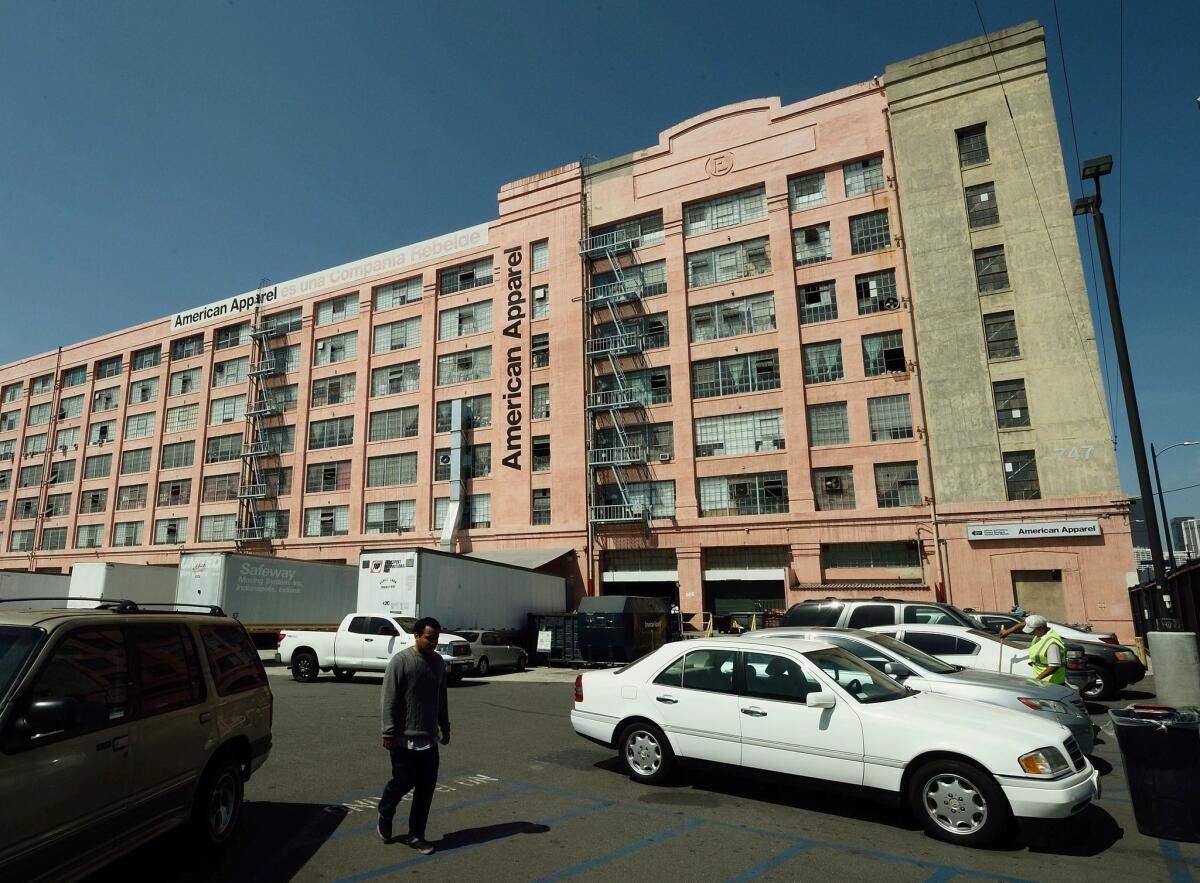With sale to Canadian firm, American Apparel will be American no longer

- Share via
With edgy marketing, an audacious founder and quality clothing sewn in Los Angeles, American Apparel was held up as a rare success story in U.S. manufacturing at a time when many in the garment industry were racing overseas.
But after years of turmoil, American Apparel is selling its brand in a bankruptcy auction to Canada’s Gildan Activewear — ending its 20-year-run as one of the country’s biggest garment makers and the employer of about 3,500 factory workers in Southern California.
Gildan agreed to pay $88 million to buy American Apparel’s intellectual property and some manufacturing equipment. The company had no interest in American Apparel’s 110 U.S. stores, and opted not to assume leases on its distribution center in La Mirada and production facilities in Garden Grove and South Gate, Gildan spokesman Garry Bell said. Employees at those manufacturing facilities and the firm’s downtown L.A. headquarters — more than 3,400 in total — could be out of work within days.
“This was always about buying assets out of bankruptcy,” Bell said. “The reality is this wasn’t a purchase of an ongoing concern.”
Most of Gildan’s business is in affordable basics such as T-shirts that can be screen-printed. In American Apparel, the company saw an opportunity to add a “premium fashion” brand that will complement its printwear business, Bell said.
It’s an inglorious end for a business that briefly became a fashion world darling while bucking many industry trends.
Founder Dov Charney charted a maverick path when he moved a nascent American Apparel to Los Angeles in 1997 and began manufacturing its cotton basics in the region. The company’s colorful garments and provocative advertising quickly caught on with young fashionistas.
Charney gained prominence as a vocal supporter of immigration reform and worker rights, as the company’s “Made in USA — Sweatshop Free” motto appeared in billboards and print ads throughout the country. At the same time, he was dogged by allegations of sexual harassment by employees that called into question the company’s commitment to the ethics it touted.
But the company has faltered in recent years. Troubles started after American Apparel began taking on massive debts to fuel its store expansion; at its height, the company had about 230 stores worldwide — many of them underperforming.
The board in 2014 voted to oust Charney as chief executive and chairman, citing allegations of sexual misconduct with employees and misuse of company funds. That set off more than two years of turmoil that tainted its brand and distracted its management from turning around the business.
Despite filing for bankruptcy for the first time in 2015, American Apparel failed to shed enough stores, which continued to be a financial drag on the company, analysts said. The board also failed to make drastic changes, such as moving more manufacturing offshore, as Charney continued to fight his ouster both in the courts and in public.
“This company has been a dead man walking for over two years,” said Craig Johnson, president of research firm Customer Growth Partners. It’s “a casualty of gross mismanagement at the top and missing-in-action board governance.”
The clothier also failed to adapt as fast-fashion retailers rocked the market for youth-oriented apparel. Its cotton basics and risque advertising faded in appeal as teenagers and twenty-somethings turned to competitors such as Forever 21 and H&M, which offered trendy designs at lower prices, analysts said.
“When you have that many stores on every corner and you don’t have a product that is differentiated, why would the customer go to that store,” said Jessica Ramirez, retail research analyst at Jane Hali & Associates.
Similar to Abercrombie & Fitch, American Apparel tried in the last two years to introduce new designs to appeal to older customers. But that kind of shift can take years, at the peril of alienating the existing customers, Ramirez said.
For Charney, the sale is a final chapter in a company that he started in his dorm room as a student at Tufts University in Medford, Mass. Charney, who is working on a new L.A. clothing company, said he tried to put together another bid for American Apparel, but the financing fell through.
“This is not a business that should have gone out of business,” he said Wednesday. “This business went out of business because of Wall Street malfeasance.”
American Apparel’s sale comes as U.S. manufacturing has become a key economic issue for President-elect Donald Trump — and a focus of prolific tweeting that has already spurred some companies to cancel plans for offshore factories.
Gildan hasn’t ruled out making some American Apparel products in the U.S., especially given the current focus on local manufacturing, Bell said.
Gildan operates manufacturing hubs in Central America and the Caribbean, where it manufactures most of its wares. It does have some plants in the U.S., including yarn-spinning facilities in North Carolina and Georgia. The only finished goods that Gildan makes in the U.S. currently are socks.
“The political climate in the U.S. has made things very fluid for a lot of companies,” Bell said. “We will evaluate all these options.”
Analysts said Gildan may make a small fraction of American Apparel items in low-cost states where Gildan already has existing production facilities. However, Gildan will probably not stay in California, especially with the minimum wage set to rise to $15 an hour in 2021, analysts said.
“They do have a plan, and that plan doesn’t involve U.S. manufacturing and certainly not Los Angeles manufacturing,” said Lloyd Greif, chief executive of investment banking firm Greif & Co. who is not involved in the deal. If they make any in America, it would be at most “a token amount.”
Charney agreed that it wouldn’t make sense for Gildan to keep any operations in California. “There is no competitive advantage for them to be located here,” he said. “The leadership is not here, the visionaries are not here.”
Bell said Gildan did not consider taking over American Apparel’s headquarters in downtown Los Angeles. That building is decades old, and Gildan does not have one factory that is older than 12 years, he said.
A Delaware bankruptcy court judge still has to approve the deal Thursday. Bell said he expects the deal to close in early February. For now, American Apparel has a 100-day lease to keep its stores open, he said.
As American Apparel stores close, the company’s goods will probably continue to find wholesale buyers — meaning concert T-shirts and corporate-branded swag will still have American Apparel tags.
Gildan also makes clothing sold through other retailers, meaning it’s likely American Apparel branded products could wind up in lower-cost chains such as Target or Kmart.
“American Apparel is headed to the discount bin,” Greif said. “What was once considered to be an upscale brand doesn’t have that cachet anymore.
Follow Shan on Twitter @ByShanLi
MORE BUSINESS NEWS
Boeing plans buyouts and layoffs for engineers
Los Angeles County brings in a record-high number of tourists in 2016
VW to plead guilty in emissions scandal; 6 high-level employees indicted
UPDATES:
3:10 p.m.: This article was updated with additional reporting
This article was originally published at 2 p.m.
More to Read
Inside the business of entertainment
The Wide Shot brings you news, analysis and insights on everything from streaming wars to production — and what it all means for the future.
You may occasionally receive promotional content from the Los Angeles Times.










